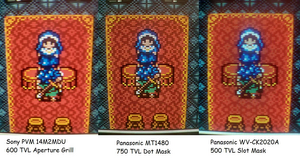Information
- Publication Type: Bachelor Thesis
- Workgroup(s)/Project(s):
- Date: March 2024
- Date (Start): 2023
- Date (End): 20. March 2024
- Matrikelnummer: 11907095
- First Supervisor: Michael Wimmer

Abstract
Games developed in the 8 and 16-bit era of computing used low-resolution images called
sprites for displaying game worlds and their objects. This art style is often referred to as
Pixel-Art and evolved into its own subgenre of games with new games still getting released
to this day. While modern Pixel-Art games incorporate the visual fidelity of modern
Liquid Crystal Display (LCD) monitors into their design, games from the Cathode Ray
Tube (CRT) era often look worse when displayed on an LCD monitor. Understandable,
since games at that time were designed to look good on CRT TVs and Monitors which
function in very different ways compared to modern Displays.
Since the upcoming of retro game console emulators, a lot of effort was put into reproducing
the effects of CRT monitors when playing back these old game files on LCD monitors. This
often requires the use of upscaling algorithms to improve the look of the low-resolution
game assets on higher-resolution monitors. Upscaling in general but also tailored towards
Pixel-Art is still an unsolved problem and the focus of many recent publications.
In this work, we will explore what effects CRT monitors have on Pixel-Art and how to
use this information to guide the upscaling of 8 and 16-bit era Pixel-Art to improve
visual fidelity when displayed on modern LCD monitors.
Additional Files and Images
Additional images and videos
Additional files
Weblinks
No further information available.
BibTeX
@bachelorsthesis{wagner-2024-par,
title = "Pixel Art Restoration",
author = "Florian Wagner",
year = "2024",
abstract = "Games developed in the 8 and 16-bit era of computing used
low-resolution images called sprites for displaying game
worlds and their objects. This art style is often referred
to as Pixel-Art and evolved into its own subgenre of games
with new games still getting released to this day. While
modern Pixel-Art games incorporate the visual fidelity of
modern Liquid Crystal Display (LCD) monitors into their
design, games from the Cathode Ray Tube (CRT) era often look
worse when displayed on an LCD monitor. Understandable,
since games at that time were designed to look good on CRT
TVs and Monitors which function in very different ways
compared to modern Displays. Since the upcoming of retro
game console emulators, a lot of effort was put into
reproducing the effects of CRT monitors when playing back
these old game files on LCD monitors. This often requires
the use of upscaling algorithms to improve the look of the
low-resolution game assets on higher-resolution monitors.
Upscaling in general but also tailored towards Pixel-Art is
still an unsolved problem and the focus of many recent
publications. In this work, we will explore what effects CRT
monitors have on Pixel-Art and how to use this information
to guide the upscaling of 8 and 16-bit era Pixel-Art to
improve visual fidelity when displayed on modern LCD
monitors.",
month = mar,
address = "Favoritenstrasse 9-11/E193-02, A-1040 Vienna, Austria",
school = "Research Unit of Computer Graphics, Institute of Visual
Computing and Human-Centered Technology, Faculty of
Informatics, TU Wien ",
URL = "https://www.cg.tuwien.ac.at/research/publications/2024/wagner-2024-par/",
}

 thesis
thesis

